Question Number 45842 by gunawan last updated on 17/Oct/18
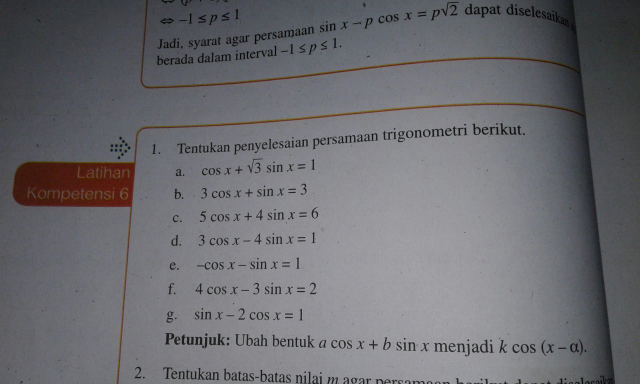
Commented by maxmathsup by imad last updated on 17/Oct/18

$${what}\:{s}\:{this}\:{language}\:{sir}\:{joel}? \\ $$
Commented by MJS last updated on 17/Oct/18

$$\mathrm{English}\:\mathrm{please} \\ $$
Commented by Joel578 last updated on 17/Oct/18

$$\mathrm{It}\:\mathrm{used}\:\mathrm{Indonesian}\:\mathrm{language} \\ $$
Commented by Joel578 last updated on 17/Oct/18
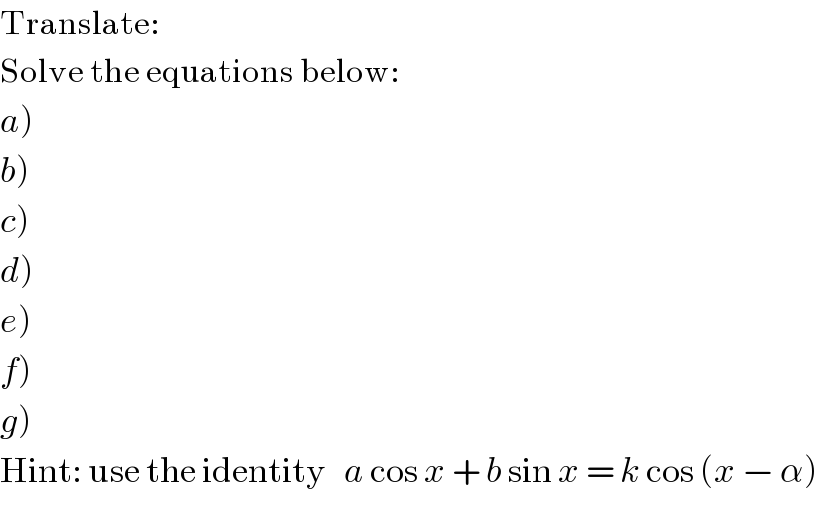
$$\mathrm{Translate}: \\ $$$$\mathrm{Solve}\:\mathrm{the}\:\mathrm{equations}\:\mathrm{below}: \\ $$$$\left.{a}\right) \\ $$$$\left.{b}\right) \\ $$$$\left.{c}\right) \\ $$$$\left.{d}\right) \\ $$$$\left.{e}\right) \\ $$$$\left.{f}\right) \\ $$$$\left.{g}\right) \\ $$$$\mathrm{Hint}:\:\mathrm{use}\:\mathrm{the}\:\mathrm{identity}\:\:\:{a}\:\mathrm{cos}\:{x}\:+\:{b}\:\mathrm{sin}\:{x}\:=\:{k}\:\mathrm{cos}\:\left({x}\:−\:\alpha\right) \\ $$
Commented by maxmathsup by imad last updated on 17/Oct/18

$${thank}\:{you}.. \\ $$
Commented by maxmathsup by imad last updated on 17/Oct/18
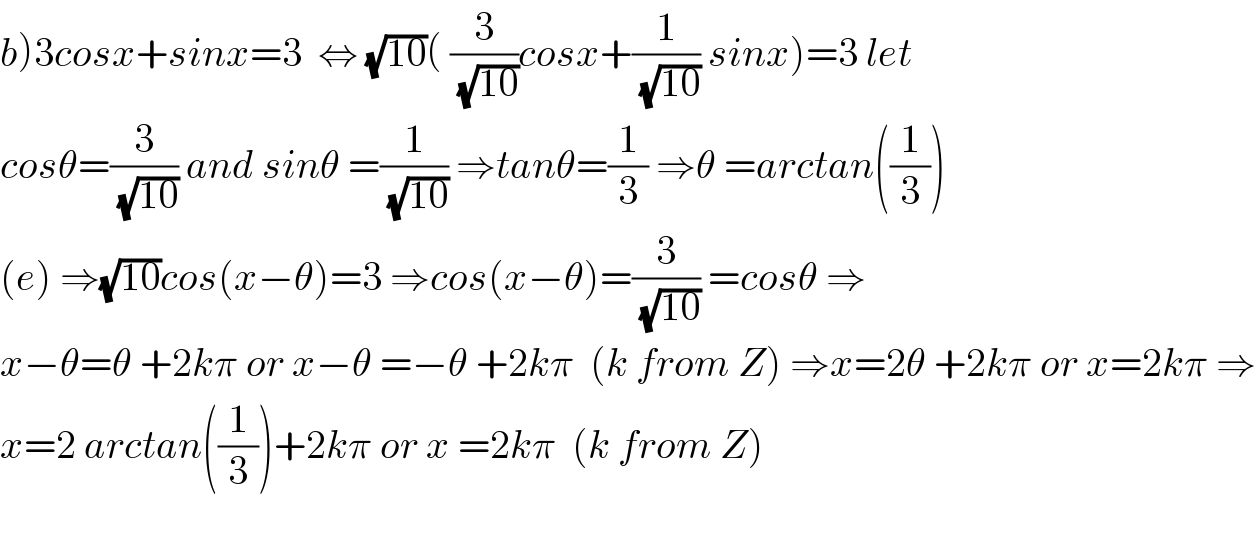
$$\left.{b}\right)\mathrm{3}{cosx}+{sinx}=\mathrm{3}\:\:\Leftrightarrow\:\sqrt{\mathrm{10}}\left(\:\frac{\mathrm{3}}{\:\sqrt{\mathrm{10}}}{cosx}+\frac{\mathrm{1}}{\:\sqrt{\mathrm{10}}}\:{sinx}\right)=\mathrm{3}\:{let} \\ $$$${cos}\theta=\frac{\mathrm{3}}{\:\sqrt{\mathrm{10}}}\:{and}\:{sin}\theta\:=\frac{\mathrm{1}}{\:\sqrt{\mathrm{10}}}\:\Rightarrow{tan}\theta=\frac{\mathrm{1}}{\mathrm{3}}\:\Rightarrow\theta\:={arctan}\left(\frac{\mathrm{1}}{\mathrm{3}}\right) \\ $$$$\left({e}\right)\:\Rightarrow\sqrt{\mathrm{10}}{cos}\left({x}−\theta\right)=\mathrm{3}\:\Rightarrow{cos}\left({x}−\theta\right)=\frac{\mathrm{3}}{\:\sqrt{\mathrm{10}}}\:={cos}\theta\:\Rightarrow \\ $$$${x}−\theta=\theta\:+\mathrm{2}{k}\pi\:{or}\:{x}−\theta\:=−\theta\:+\mathrm{2}{k}\pi\:\:\left({k}\:{from}\:{Z}\right)\:\Rightarrow{x}=\mathrm{2}\theta\:+\mathrm{2}{k}\pi\:{or}\:{x}=\mathrm{2}{k}\pi\:\Rightarrow \\ $$$${x}=\mathrm{2}\:{arctan}\left(\frac{\mathrm{1}}{\mathrm{3}}\right)+\mathrm{2}{k}\pi\:{or}\:{x}\:=\mathrm{2}{k}\pi\:\:\left({k}\:{from}\:{Z}\right) \\ $$$$ \\ $$
Commented by gunawan last updated on 18/Oct/18

$$\mathrm{thank}\:\mathrm{you}\:\mathrm{very}\:\mathrm{much}\:\mathrm{sir} \\ $$
Commented by hknkrc46 last updated on 29/Nov/18
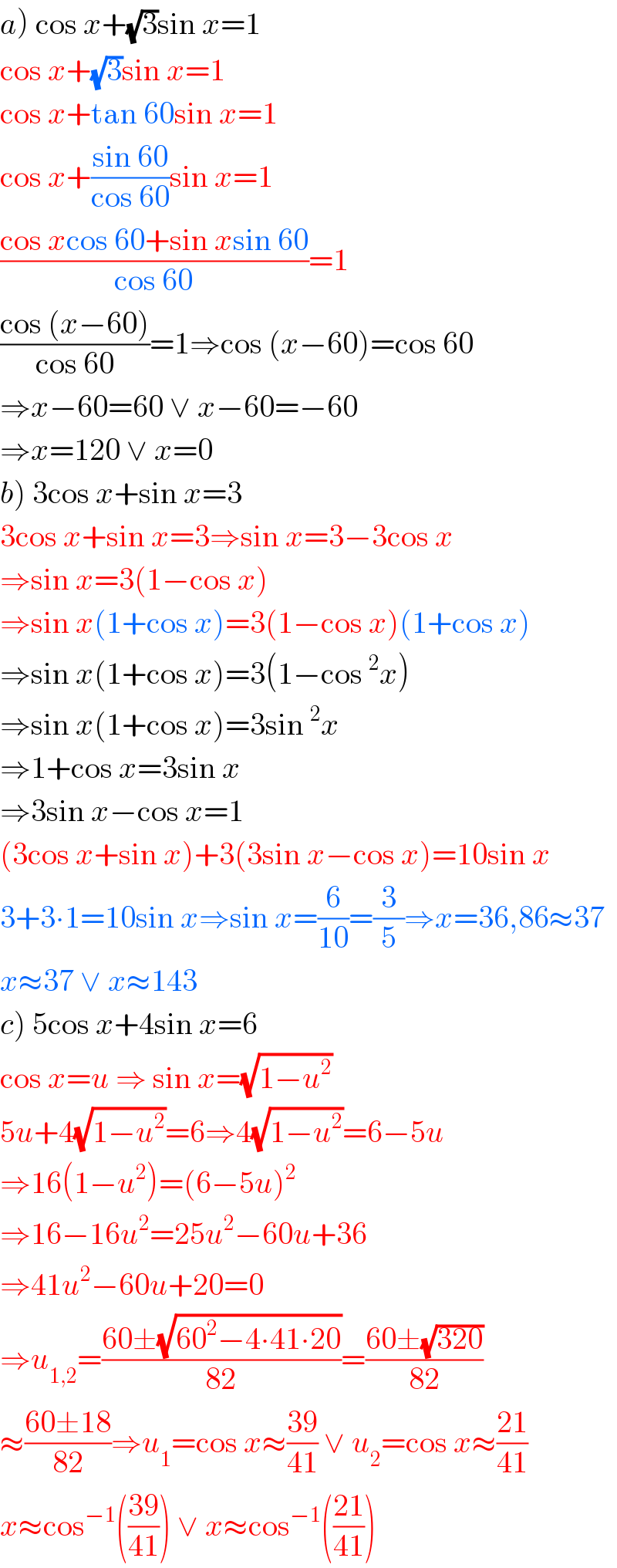
$$\left.{a}\right)\:\mathrm{cos}\:{x}+\sqrt{\mathrm{3}}\mathrm{sin}\:{x}=\mathrm{1} \\ $$$$\mathrm{cos}\:{x}+\sqrt{\mathrm{3}}\mathrm{sin}\:{x}=\mathrm{1} \\ $$$$\mathrm{cos}\:{x}+\mathrm{tan}\:\mathrm{60sin}\:{x}=\mathrm{1} \\ $$$$\mathrm{cos}\:{x}+\frac{\mathrm{sin}\:\mathrm{60}}{\mathrm{cos}\:\mathrm{60}}\mathrm{sin}\:{x}=\mathrm{1} \\ $$$$\frac{\mathrm{cos}\:{x}\mathrm{cos}\:\mathrm{60}+\mathrm{sin}\:{x}\mathrm{sin}\:\mathrm{60}}{\mathrm{cos}\:\mathrm{60}}=\mathrm{1} \\ $$$$\frac{\mathrm{cos}\:\left({x}−\mathrm{60}\right)}{\mathrm{cos}\:\mathrm{60}}=\mathrm{1}\Rightarrow\mathrm{cos}\:\left({x}−\mathrm{60}\right)=\mathrm{cos}\:\mathrm{60} \\ $$$$\Rightarrow{x}−\mathrm{60}=\mathrm{60}\:\vee\:{x}−\mathrm{60}=−\mathrm{60} \\ $$$$\Rightarrow{x}=\mathrm{120}\:\vee\:{x}=\mathrm{0} \\ $$$$\left.{b}\right)\:\mathrm{3cos}\:{x}+\mathrm{sin}\:{x}=\mathrm{3} \\ $$$$\mathrm{3cos}\:{x}+\mathrm{sin}\:{x}=\mathrm{3}\Rightarrow\mathrm{sin}\:{x}=\mathrm{3}−\mathrm{3cos}\:{x} \\ $$$$\Rightarrow\mathrm{sin}\:{x}=\mathrm{3}\left(\mathrm{1}−\mathrm{cos}\:{x}\right) \\ $$$$\Rightarrow\mathrm{sin}\:{x}\left(\mathrm{1}+\mathrm{cos}\:{x}\right)=\mathrm{3}\left(\mathrm{1}−\mathrm{cos}\:{x}\right)\left(\mathrm{1}+\mathrm{cos}\:{x}\right) \\ $$$$\Rightarrow\mathrm{sin}\:{x}\left(\mathrm{1}+\mathrm{cos}\:{x}\right)=\mathrm{3}\left(\mathrm{1}−\mathrm{cos}\:^{\mathrm{2}} {x}\right) \\ $$$$\Rightarrow\mathrm{sin}\:{x}\left(\mathrm{1}+\mathrm{cos}\:{x}\right)=\mathrm{3sin}\:^{\mathrm{2}} {x} \\ $$$$\Rightarrow\mathrm{1}+\mathrm{cos}\:{x}=\mathrm{3sin}\:{x} \\ $$$$\Rightarrow\mathrm{3sin}\:{x}−\mathrm{cos}\:{x}=\mathrm{1} \\ $$$$\left(\mathrm{3cos}\:{x}+\mathrm{sin}\:{x}\right)+\mathrm{3}\left(\mathrm{3sin}\:{x}−\mathrm{cos}\:{x}\right)=\mathrm{10sin}\:{x} \\ $$$$\mathrm{3}+\mathrm{3}\centerdot\mathrm{1}=\mathrm{10sin}\:{x}\Rightarrow\mathrm{sin}\:{x}=\frac{\mathrm{6}}{\mathrm{10}}=\frac{\mathrm{3}}{\mathrm{5}}\Rightarrow{x}=\mathrm{36},\mathrm{86}\approx\mathrm{37} \\ $$$${x}\approx\mathrm{37}\:\vee\:{x}\approx\mathrm{143} \\ $$$$\left.{c}\right)\:\mathrm{5cos}\:{x}+\mathrm{4sin}\:{x}=\mathrm{6} \\ $$$$\mathrm{cos}\:{x}={u}\:\Rightarrow\:\mathrm{sin}\:{x}=\sqrt{\mathrm{1}−{u}^{\mathrm{2}} } \\ $$$$\mathrm{5}{u}+\mathrm{4}\sqrt{\mathrm{1}−{u}^{\mathrm{2}} }=\mathrm{6}\Rightarrow\mathrm{4}\sqrt{\mathrm{1}−{u}^{\mathrm{2}} }=\mathrm{6}−\mathrm{5}{u} \\ $$$$\Rightarrow\mathrm{16}\left(\mathrm{1}−{u}^{\mathrm{2}} \right)=\left(\mathrm{6}−\mathrm{5}{u}\right)^{\mathrm{2}} \\ $$$$\Rightarrow\mathrm{16}−\mathrm{16}{u}^{\mathrm{2}} =\mathrm{25}{u}^{\mathrm{2}} −\mathrm{60}{u}+\mathrm{36} \\ $$$$\Rightarrow\mathrm{41}{u}^{\mathrm{2}} −\mathrm{60}{u}+\mathrm{20}=\mathrm{0} \\ $$$$\Rightarrow{u}_{\mathrm{1},\mathrm{2}} =\frac{\mathrm{60}\pm\sqrt{\mathrm{60}^{\mathrm{2}} −\mathrm{4}\centerdot\mathrm{41}\centerdot\mathrm{20}}}{\mathrm{82}}=\frac{\mathrm{60}\pm\sqrt{\mathrm{320}}}{\mathrm{82}} \\ $$$$\approx\frac{\mathrm{60}\pm\mathrm{18}}{\mathrm{82}}\Rightarrow{u}_{\mathrm{1}} =\mathrm{cos}\:{x}\approx\frac{\mathrm{39}}{\mathrm{41}}\:\vee\:{u}_{\mathrm{2}} =\mathrm{cos}\:{x}\approx\frac{\mathrm{21}}{\mathrm{41}} \\ $$$${x}\approx\mathrm{cos}^{−\mathrm{1}} \left(\frac{\mathrm{39}}{\mathrm{41}}\right)\:\vee\:{x}\approx\mathrm{cos}^{−\mathrm{1}} \left(\frac{\mathrm{21}}{\mathrm{41}}\right) \\ $$
Answered by Joel578 last updated on 17/Oct/18
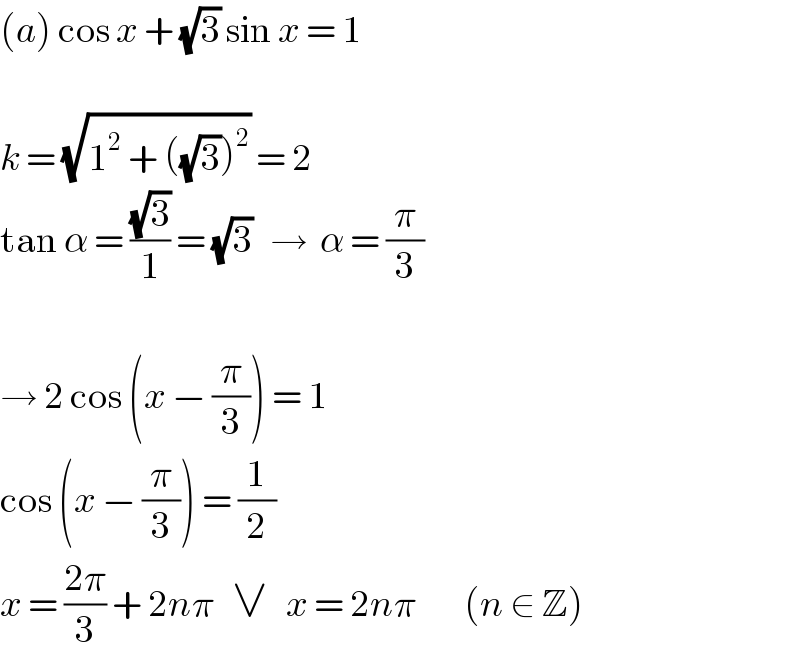
$$\left({a}\right)\:\mathrm{cos}\:{x}\:+\:\sqrt{\mathrm{3}}\:\mathrm{sin}\:{x}\:=\:\mathrm{1} \\ $$$$ \\ $$$${k}\:=\:\sqrt{\mathrm{1}^{\mathrm{2}} \:+\:\left(\sqrt{\mathrm{3}}\right)^{\mathrm{2}} }\:=\:\mathrm{2} \\ $$$$\mathrm{tan}\:\alpha\:=\:\frac{\sqrt{\mathrm{3}}}{\mathrm{1}}\:=\:\sqrt{\mathrm{3}}\:\:\:\rightarrow\:\:\alpha\:=\:\frac{\pi}{\mathrm{3}} \\ $$$$ \\ $$$$\rightarrow\:\mathrm{2}\:\mathrm{cos}\:\left({x}\:−\:\frac{\pi}{\mathrm{3}}\right)\:=\:\mathrm{1} \\ $$$$\mathrm{cos}\:\left({x}\:−\:\frac{\pi}{\mathrm{3}}\right)\:=\:\frac{\mathrm{1}}{\mathrm{2}} \\ $$$${x}\:=\:\frac{\mathrm{2}\pi}{\mathrm{3}}\:+\:\mathrm{2}{n}\pi\:\:\:\vee\:\:\:{x}\:=\:\mathrm{2}{n}\pi\:\:\:\:\:\:\:\:\left({n}\:\in\:\mathbb{Z}\right) \\ $$
Commented by gunawan last updated on 18/Oct/18

$$\mathrm{thanks} \\ $$
